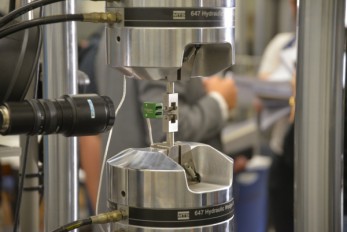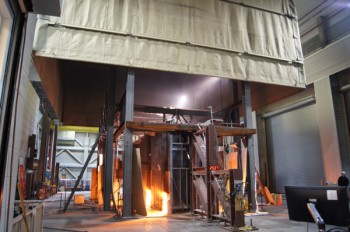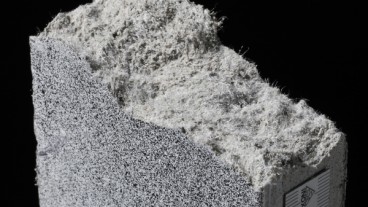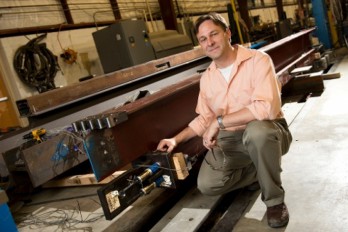Composite Metal Foams ready for industry applications

Composite Metal Foams (CFMs) have come closer to commercial applications after successfully passing the “simulated pool fire testing”.
CFMs are materials that consist of metallic spheres usually made of steel or titanium. What is unique about these materials is that the spheres are hollow and they are embedded in a matrix that consists of aluminum, steel or other alloys. As a result, CFMs have high porosity and are much lighter than common metals.
Scientists from North Carolina State University conducted the aforementioned tests to evaluate the performance of steel-steel CFMs, meaning that they consist of steel hollow spheres in a steel matrix panel. Simulated pool fire testing is an experimental procedure that every material has to sustain in order to be approved and utilized in the transportation of dangerous substances. The results of the study were published at the International Journal of Thermal Sciences.
During the testing process, a 15.9-millimeter slate made of the material of interest is exposed to a minimum of 816 °C. The heat is applied to one side of the panel while a temperature sensor is installed on its opposite side. The duration of the process is 100 minutes and the material passes the test only if the temperature of the sensor remains below 427 °C throughout the procedure.
CFMs proved to be successful and easily passed the test while a normal steel plate failed. “In three rounds of testing, our steel-steel CMF was exposed to the same temperatures of 825 degrees Celsius for the full 100 minutes – and the highest temperatures recorded on the back of the panel using protected sensors were between 351 and 379 degrees Celsius. It is worth noting that the steel-steel CMF is only one-third of the weight of the solid steel plate that failed the test in about 12 minutes," Afsaneh Rabie, lead author of the study and a Professor of Mechanical and Aerospace Engineering at North Carolina State University, stated.
The new findings follow another significant discovery about CFMs made by the NC State University in 2016. Back then, it was found that they are more efficient when it comes to heat insulation compared to conventional metals.
Moreover, the experimental results provided researchers with new data that could aid in improving their manufacturing process and adjust it depending on the application needed. “Because we can control the features of the CMF, such as the size of the hollow spheres in the foam, we wanted to create a model that could be used to predict how different types of CMF would perform in simulated pool fire testing. This would allow us to design future foams in order to find the best balance of physical, mechanical and thermal properties,” Prof. Rabie, added.
Scientists emphasize that CFMs can be the future components used for the transportation of hazardous materials (e.g. nuclear waste or explosives).
Source: North Carolina State University
Source: North Carolina State University
Want to read more like this story?
The future of steel production and steel structure construction
Nov, 30, 2022 | NewsThis article will explore four technologies that are helping shape the future of steel construction...

Green Steel Production: The Future of Civil Engineering
Jun, 21, 2024 | NewsThe Importance of Steel in Modern Construction Steel is the backbone of contemporary construction,...

Second Life for Steel: The Rise of Circular Bridges
Apr, 27, 2025 | NewsA shift is underway in civil engineering as reuse—not just recycling—of steel becomes a cornerstone...

Researchers produce high strength steel with increased fracture resistance and ductility
May, 07, 2020 | NewsScientists from the University of Hong Kong and the Lawrence Berkeley National Laboratory have manag...

UK Steel Industry Under Pressure: Rising Imports and Global Oversupply Threaten Stability
Oct, 15, 2024 | NewsThe UK steel industry is at a critical turning point as global overproduction and an influx of chea...

Study on the impact of fires in high-rise buildings
Apr, 21, 2020 | NewsResearchers from the U.S. National Institute of Standards and Technology (NIST), conducted a thoroug...

Steel-Framed Curtain Walls: Engineering Marvel at Oklahoma’s Eco-Friendly Bank
Jun, 27, 2024 | NewsThe First United Bank has recently opened a new, state-of-the-art building in Moore, Oklahoma, desi...

New sustainable material that will replace steel in reinforced concrete
Dec, 27, 2019 | NewsA new technique that involves replacing steel with polyethylene in reinforced concrete has been deve...

Ductility in Steel Beams Improved by Geometric Cutouts
Mar, 23, 2015 | NewsThe ability of steel buildings to bend without fracturing, or ductility, allows for extreme lateral...
Trending

Vertical gardens in Mexico City to combat pollution

Saudi Park Closed After 360 Big Pendulum Ride Crashes to Ground, 23 injured

Characteristics of Load Bearing Masonry Construction

Taipei 101’s impressive tuned mass damper

Dutch greenhouses have revolutionized modern farming

Federal court rules Biden’s offshore drilling ban unlawful


